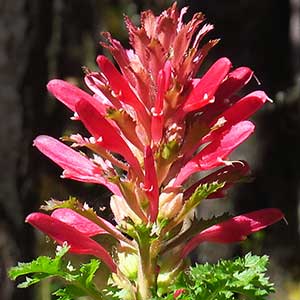Pedicularis densiflora
Pedicularis cystopteridifolia
Indian warrior, warrior's plume
fern-leaf lousewort, fernleaf pedicularis
basal 1–10, blade lanceolate, 30–200 x 20–70 mm, 2(or 3)-pinnatifid, margins of adjacent lobes nonoverlapping or extensively overlapping distally, 1-serrate, surfaces glabrous, hispid, or downy;
cauline 4–20, blade lanceolate, 15–250 x 5–100 mm, 2-pinnatifid, margins of adjacent lobes nonoverlapping or extensively overlapping distally, serrate, surfaces glabrous, hispid, or downy.
basal 2–10, blade elliptic to lanceolate, 20–90 x 5–15 mm, 2(or 3)-pinnatifid, margins of adjacent lobes nonoverlapping to extensively overlapping distally, serrate, surfaces glabrous;
cauline 2–8, blade triangular to lanceolate, 20–120 x 5–20 mm, 1- or 2-pinnatifid, margins of adjacent lobes nonoverlapping or extensively overlapping distally, serrate, surfaces glabrous or unevenly hispid to tomentose.
simple, 1–5, exceeding basal leaves, each 10–50-flowered;
bracts lanceolate to trullate, 10–35 x 3–5 mm, undivided or 1-pinnatifid, proximal margins entire, distal 1- or 2-serrate, surfaces glabrous.
simple, 1–2, exceeding basal leaves, each 10–40-flowered;
bracts trullate to obtrullate or subulate to trullate, 10–25 x 2–5 mm, undivided or 1- or 2-auricled, sometimes 1-pinnatifid, proximal margins entire, distal entire or serrate, surfaces tomentose.
2–4 mm.
1–3 mm.
calyx 9–18 mm, downy to tomentose, lobes 5, triangular, 3–4 mm, apex entire, ciliate;
corolla 23–43 mm, tube dark red, purple, or orange-yellow, rarely white, 8–18 mm;
galea dark red, purple, or orange-yellow, rarely white, 15–25 mm, beakless, margins entire medially and distally, apex straight;
abaxial lip dark red, purple, or orange-yellow, rarely white, 8–15 mm.
calyx 8–12 mm, tomentose, lobes 5, narrowly triangular, 3–4 mm, apex entire, ciliate;
corolla 20–26 mm, tube red or pink, 13–15 mm;
galea red or pink, 7–11 mm, beakless, margins entire medially, 1-toothed distally, apex arching over abaxial lip;
abaxial lip red or pink, 6–7.5 mm.
= 16.
= 32.
Pedicularis densiflora
Pedicularis cystopteridifolia
Scarlet corollas with an undomed, toothless galea and two- or three-pinnatifid leaves are diagnostic of Pedicularis densiflora. This species occurs in forested subalpine regions of southern Oregon, western slopes of the Sierra Nevada, and the Coast Ranges of California south to Baja California. Herbarium records indicate northern populations of P. densiflora occur at higher elevations than do more southern populations.
(Discussion copyrighted by Flora of North America; reprinted with permission.)
Pedicularis cystopteridifolia occurs only in the Rocky Mountains of Montana and Wyoming. As the specific epithet implies, the leaves strongly resemble those of the fern Cystopteris fragilis. Although not sympatric, this species could easily be misidentified as P. sudetica subsp. scopulorum, which has flowers of a similar shape and color, and leaves that are also two-pinnatifid. The secondary leaf lobes of P. cystopteridifolia, however, are much larger, longer, more deeply incised, and more heavily toothed, making them appear more finely dissected than the linear to deltate secondary and smaller toothed lobes of P. sudetica. Many of the adjacent leaf lobes of P. cystopteridifolia also overlap, whereas the lobes of P. sudetica are more widely spaced and therefore not overlapping. The galea of P. cystopteridifolia is also more highly domed and broader, and the leaves are a paler shade of green in contrast to the dark green leaves of P. sudetica subsp. scopulorum.
(Discussion copyrighted by Flora of North America; reprinted with permission.)


